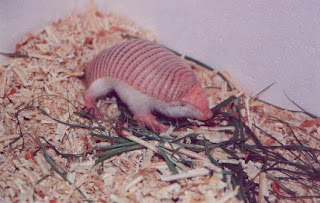
The conservation status of the pink fairy armadillo is uncertain. They have nocturnal and solitary habits and a diet largely composed of insects (mainly ants and beetles), worms, snails, and small amounts of roots and other plant parts ( Minoprio, 1945 Guinazu Rawson de Arentsen, 1956 Cei, 1967). Yepes ( 1928, 1929, 1931, 1932), Minoprio ( 1945), Guiñazú Rawson de Arentsen ( 1956), Cei ( 1967), and Meritt ( 1985) have reported on the natural history and geographical distribution of pink fairy armadillos. A vertical plate at the rear of the carapace gives it a rather blunt end (to which the name truncatus refers), from which a spatula-shaped tail protrudes ( Minoprio, 1945 Guiñazú Rawson de Arentsen, 1956). It has minute eyes its fine silky fur is yellowish white and its flexible dorsal shell of about 24 bands is attached to the body only by a thin dorsal membrane. This species is the smallest living armadillo (Dasypodidae), and is amongst the least known subterranean mammals. The pink fairy armadillo is a desert-adapted, strictly subterranean armadillo ( Cei, 1967 Borghi et al., 2002) endemic to central Argentina, where it inhabits sandy plains, dunes, and scrubby grasslands dominated by sparse shrubs of creosotebush ( Larrea spp.) and by Portulaca plants in the wet season (spring and summer). William Colesberry when presenting a specimen to the Philadelphia Museum. The pink fairy armadillo Chlamyphorus truncatus was described by Harlan ( 1835), who used its native name “pichiciago”, mentioned by Mr. The conservation of the pink fairy armadillo depends on the maintenance of the arid and semiarid habitats where this species occurs, with commercial agriculture, pesticides, extensive livestock farming, and prédation by domestic dogs and cats, posing the threats of greatest concern. The rate at which new records are accrued has increased, arguably reflecting a greater interest in the species and greater presence of field workers in the species range.

We added new registers outside the historical distribution south of Mendoza province, north of Río Negro province and south of Buenos Aires province, effectively extending the species range. truncatus persist in localities along most of the species' historical range, including at least 12 sites with recurrent pink fairy armadillo records. Recent records suggest that populations of C.
PINK FAIRY ARMADILLO UPDATE
We compiled records from the literature, museum and private collections, information from rural people, and researchers to update the species' current distribution and conservation threats. The distribution and ecology of the pink fairy armadillo Chlamyphorus truncatus, the world's smallest armadillo, are poorly understood due largely to the strictly subterranean habits of this species.


 0 kommentar(er)
0 kommentar(er)
